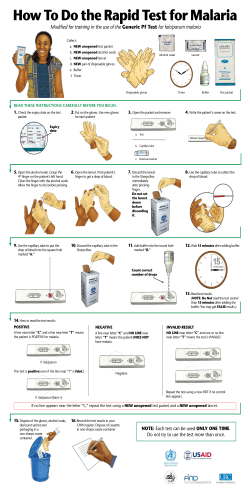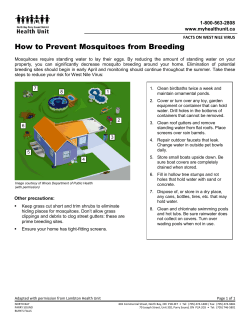
Eamonn Keogh What can Computer Science do for Malaria Research?
Eamonn Keogh Computer Science & Engineering Department University of California - Riverside Riverside, CA 92521 eamonn@cs.ucr.edu What can Computer Science do for Malaria Research? Outline • • • • • What is malaria? How big of a problem is it? Interventions that help mitigate malaria Some facts about mosquitoes Our efforts to help in the war on malaria • Conclusions What is Malaria? • Malaria is a disease that involves high fevers, shaking chills, joint pain, flu-like symptoms, and anemia. In some cases it can produce coma and death. • There are more than 225 million cases of malaria each year, killing around 1-million people. Where does Malaria come from? Malaria has been known since ancient times. Many believed it came from “bad air” (Italian: mala aria, “bad air”) 500 years ago, a handful of people believed that insects might be involved in human diseases. It was Sir Ronald Ross, an British army surgeon working in India, who proved in 1897 that malaria is transmitted by mosquitoes. Sir Ronald Ross received the 1902 Nobel Prize for Physiology or Medicine for his work (This was somewhat controversial, as many others made similar discoveries around the same time ) Malaria Parasites Malaria Transmission Cycle 1st Vector Initial Human host Next Human host Liver infection 2nd Vector Blood infection The Mosquito • There are 3,528 kinds of mosquitoes • Only a handful take human blood • Only the females take human blood • There are 100 trillion mosquitoes alive today • Mosquitoes have been around for at least 100 million years • We know this from fossil records/DNA studies • Mosquitoes have spread malaria for at least 35 million years • We know this from insects found in amber Where does malaria cause problems? www.worldmapper.org “In every US military campaign (in the 20th) century we lost more casualties to malaria than bullets” Navy Dr. (Capt.) Stephen L. Hoffman Malaria causes poverty and poverty causes malaria • According to the United Nations Children’s Fund “Malaria is truly a disease of poverty. It afflicts primarily the poor, who tend to live in malariaprone areas in dwellings that offer few, if any, barriers against mosquitoes”. • Sachs and Malaney argue that “as a general rule of thumb, where malaria prospers most, human societies have prospered least…. The extent of the correlation suggests that malaria and poverty are intimately related.” Given that we have known for over one hundred years how Malaria is spread, where is the magic pill or immunization? For a variety of reasons, a cure or immunization continues to alluded mankind. “Ague” is an old word for malaria (It appears in several of Shakespeare's plays) However there are some interventions that can help Interventions to Mitigate Malaria • • • • • • The use of insecticidal treated mosquito nets Spraying of insecticides (including controversial chemicals such as DDT) Introduction of fish/turtles/crustaceans to eat mosquito larva The introduction of dragonflies which eat adult mosquitoes. Habitat reduction by draining ponds and pools Use of chemical films to reduce the surface tension of water (drowning the pupa). • .. and hundreds more proven or tentative ideas Some interventions have been around a long time, as this 1963 Chinese poster shows: • Use bed-nets • Spraying insecticides • Filling in ditches (habitat reduction) • Raising fish to eat the larvae Interventions Cost Money! • Even cheap solutions have hidden costs • Insecticidal treated mosquito nets are cheap to make, but… “...aid agencies and non-governmental organizations are quietly grappling with a problem: Data suggest that nearly half of Africans who have access to the nets refuse to sleep under them” (LA Times May-2-2010). • To make mosquito nets work, you need educators, incentive programs, maintenance etc The Malaria Mantra • Do it cheap, or don’t bother Suppose you want to do some intervention in Africa, and you have enough money for 65 sites…. The obvious thing to do is to spread your 65 efforts evenly across the target location.. No mosquitoes Some mosquitoes Rampant mosquitoes Suppose this is a true map of mosquito activity. We have wasted resources No mosquitoes Some mosquitoes Rampant mosquitoes This is how we should have spend our money, resources, time I have shown this example on all of Africa for visual clarity. However most mosquitoes spend their entire lives less than a mile from where they where hatched, so we want to do this on a very fine grain area. (city-block sized parcels) Planning interventions requires knowledge • We need to know where the problem is the greatest. Where are the mosquitoes? • We can measure surrogates – Hospital admissions (too late) – Weather data (too imprecise) • We can use sticky traps – Inaccurate – Costly – Long time lag Our Contributions • We believe that we can count and classify insects with sensors. – Must be cheap (to allow wide deployment, to deter thief) – Must be low powered (we may not have mains electricity) – Must be accurate Phototransistor Laser Circuit Board Insect Detected Insect detection threshold 0 500 1000 One second of audio from the laser sensor. Only Bombus impatiens (Common Eastern Bumble Bee) is in the insectary. 0.2 0.1 0 Background noise -0.1 Bee begins to cross laser -0.2 0.5 1 1.5 2 2.5 x 10-3 3 2 1 0 0 3 3.5 Single-Sided Amplitude Spectrum of Y(t) 4 |Y(f)| 0 Peak at 197Hz 60Hz interferen ce 100 Harmonics 200 300 400 500 600 Frequency (Hz) 700 800 900 1000 4 x 10 4 4.5 x 10-3 |Y(f)| 4 Peak at 197Hz 3 2 1 0 0 100 200 300 400 500 600 700 800 900 1000 Frequency (Hz) 100 200 300 400 500 Frequency (Hz) 600 700 800 x 10-3 |Y(f)| 4 More peaks 3 2 1 0 0 100 200 300 400 500 600 700 800 900 1000 Frequency (Hz) Bombus impatiens 100 200 300 400 500 Frequency (Hz) 600 700 800 2000 1800 Number of one-second fragments 1600 1400 1200 1000 Culex quinquefasciatu 800 600 Aedes aegypti 400 Bombus impatiens 200 0 100 200 300 400 500 Frequency (Hz) 600 700 800 Peak at 210Hz 0 100 200 300 400 500 600 700 800 900 1000 Frequency (Hz) Culex quinquefasciatu Aedes aegypti Bombus impatiens 100 200 300 400 500 Frequency (Hz) Almost certainly a bee 600 700 800 Peak at 705 Hz 0 100 200 300 400 500 600 700 800 900 1000 Frequency (Hz) Culex quinquefasciatu Aedes aegypti Bombus impatiens 100 200 300 400 500 Frequency (Hz) Almost certainly a Aedes aegypti 600 700 800 Peak at 602 Hz 0 100 200 300 400 500 600 700 800 900 1000 Frequency (Hz) Culex quinquefasciatu Aedes aegypti Bombus impatiens 100 200 300 400 500 600 700 800 Frequency (Hz) Could be a Culex quinquefasciatu or a Aedes aegypti More work needs to be done! • In the example on the previous page, we are 96.04% accurate. • We are working on extracting more features to improve this accuracy • We have a 100K grant from the Bill and Melinda gates foundation. Soon we will try for a million dollar phase II • We plan “spin-off” applications in agriculture Conclusions We have seen: – What malaria is – How big of a problem it is – Some Interventions that help mitigate malaria – A brief look at our efforts to help in the war on malaria • Thanks to my post-doc, Gustavo E.A.P.A. Batista and industrial collaborator Agenor Mafra-Neto Questions?
© Copyright 2025



















